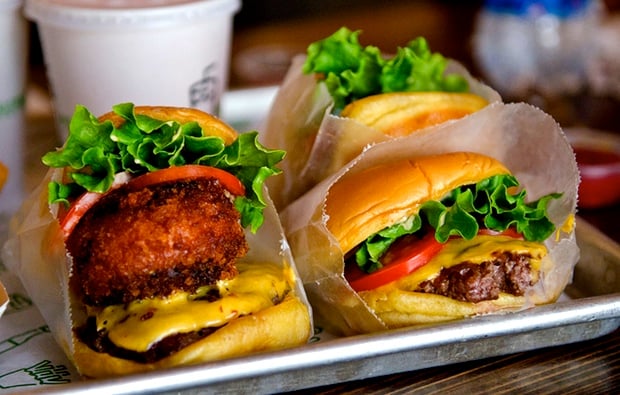Although Shake Shack only has two locations in Washington, judging by the chronic long lines at its Dupont Circle location, it’s safe to say it’s a hit. The modern burger-and-hot-dog “roadside stand”–which also makes decadent shakes and frozen custard treats–first arrived from New York last year to significant fanfare.
Although burgers and hot dogs aren’t the first foods that come to mind when we think of eating well, Shake Shack does boast local ingredients, vegetarian-fed, humanely raised beef that’s ground fresh daily, and Vienna Beef and Usinger’s sausages–even sustainably bottled water.
We asked Cheryl Harris, RD, to take a look at the simple menu and see if these attributes could make Shake Shack a healthy fast food option.
“It would be challenging to get a healthy meal there–there aren’t many vegetables you can get,” Harris says, apart from the basic lettuce, tomato, and pickle you can opt for on any burger.
Check out her breakdown on dining at Shake Shack to find out what to order without overdoing it.
BURGERS and FLAT-TOP DOGS
• Worst–Double Shack Burger and Shack Stack: These burgers are neck-and-neck on the poor-choice meter. The Shack Stack, with its cheese-packed portobello mushroom cap and beef patty, is higher in calories, fat, and saturated fat (with 850 calories and 55 grams of fat, 22 saturated); but the Double Shack Burger, packs more sodium (1,410 milligrams) and more trans fat.
• Better–Single burger: “Any of the single burgers are better options,” Harris says. “It’s a significant enough portion to be filling without breaking the bank health-wise.” At 360 calories, 450 milligrams of sodium, and 26 grams of protein, it’s reasonable enough that you can afford to have dessert, too.
• Best–Bird dog: At a mere 250 calories, 660 milligrams of sodium, and 21 grams of protein, the chicken, apple, and sage sausage is a great meal. Harris says, “You’re getting enough protein to feel full, but it’s not so high in calories that you can’t squeeze a scoop of vanilla or split an order of fries in addition.”
BONUS–BEST DESSERT
• Single-dip ice cream: The restaurant’s ice cream is made with hormone-free milk. Top your vanilla, chocolate, or flavor-of-the day scoop with seasonal fresh fruit–“that always adds fun, taste, and nutritional value,” our expert explains.
Okay, so overall, Shake Shack might not be a good idea for those who are trying to maintain a healthy diet or a slim waistline. Luckily, Harris had a few more tips up her sleeve for enjoying the eatery responsibly.
“The best rules of thumb are that people can make the best decisions when they know the calories; that it’s important to bring a friend to share [food] with; and that they should follow my ‘pick two’ rule,” Harris says. The pick two rule means choosing your burger or hot dog and then one other item, be it a soda, fries, or a frozen treat.
Additionally, pay attention to portion sizes. “One of the biggest things with Americans is that we tend think any amount of food in front of us is a proper serving size, when really it might not even be double of what we need, but triple,” our expert explains. Also remember to be careful with the hot dogs, which are typically fatty and potentially high in carcinogenic nitrates.
Shake Shack does get Harris’s stamp of approval for its gluten-free provisions and easy-to-find information. She notes, however, that cross-contamination might be an issue since the restaurant filters and reuses its cooking oil.
“It looks like a fun place, like the hot dog stands at Coney Island,” Harris says, “but nutritionally it’s a hard place to swing.”



















